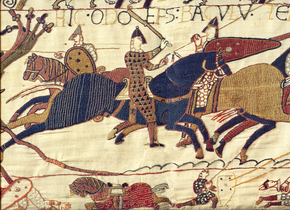
The Bayeux Tapestry[a] is an embroidered cloth nearly 70 metres (230 feet) long and 50 centimetres (20 inches) tall[1] that depicts the events leading up to the Norman Conquest of England in 1066, led by William, Duke of Normandy challenging Harold II, King of England, and culminating in the Battle of Hastings. It is thought to date to the 11th century, within a few years of the battle. Now widely accepted to have been made in England, perhaps as a gift for William, it tells the story from the point of view of the conquering Normans and for centuries has been preserved in Normandy.
According to Sylvette Lemagnen, conservator of the tapestry, in her 2005 book La Tapisserie de Bayeux:
The Bayeux tapestry is one of the supreme achievements of the Norman Romanesque .... Its survival almost intact over nine centuries is little short of miraculous ... Its exceptional length, the harmony and freshness of its colours, its exquisite workmanship, and the genius of its guiding spirit combine to make it endlessly fascinating.[2]
The cloth consists of 58 scenes,[note 1] many with Latin tituli, embroidered on linen with coloured woollen yarns. It is likely that it was commissioned by Bishop Odo of Bayeux, William's maternal half-brother, and made for him in England in the 1070s. In 1729, the hanging was rediscovered by scholars at a time when it was being displayed annually in Bayeux Cathedral. The tapestry is now exhibited at the Musée de la Tapisserie de Bayeux in Bayeux, Normandy, France (49°16′28″N 0°42′01″W / 49.2744°N 0.7003°W).
The designs on the Bayeux Tapestry are embroidered rather than in a tapestry weave, so it does not meet narrower definitions of a tapestry.[5] Nevertheless, it has always been referred to as a tapestry until recent years when the name "Bayeux Embroidery" has gained ground among certain art historians. It can be seen as a rare example of secular Romanesque art. Tapestries adorned both churches and wealthy houses in Medieval Western Europe, though at 0.5 by 68.38 m (1 ft 8 in by 224 ft 4 in), the Bayeux Tapestry is exceptionally large. The background is not embroidered, providing a large, clear field of cloth which allows the figures and decorative elements to stand out very clearly.
Cite error: There are <ref group=lower-alpha> tags or {{efn}} templates on this page, but the references will not show without a {{reflist|group=lower-alpha}} template or {{notelist}} template (see the help page).
- ^ Caviness, Madeline H. (2001). Reframing Medieval Art: Difference, Margins, Boundaries. Medford, MA: Tufts University.; Koslin, Desirée (1990). "Turning Time in the Bayeux Embroidery". Textile & Text. 13: 28–29.; Bertrand, Simone (1966). La tapisserie de Bayeux. La Pierre-qui-Vire: Zodiaque. p. 23.
et combien pauvre alors ce nom de broderie nous apparaît-il!
- ^ Sylvette Lemagnen, Preface, p. 9; Musset, Lucien (1 November 2005) [1989]. La Tapisserie de Bayeux: œuvre d'art et document historique [The Bayeux Tapestry] (annotated edition). Translated by Rex, Richard (First ed.). Woodbridge, United Kingdom: Boydell & Brewer Ltd. p. 272. ISBN 978-1-84383-163-1.
- ^ "Explore the Bayeux Tapestry online". Bayeux Museum. Retrieved 17 July 2022.
- ^ Freeman, Henry (21 March 2016). The Middle Ages: A History From Beginning to End. Hourly History. ISBN 978-1-5303-7624-7.
- ^ Saul, Nigel. "Bayeux Tapestry". A Companion to Medieval England. Stroud, UK: Tempus. pp. 32–33. ISBN 0-7524-2969-8. But see OED s.v. "tapestry": "A textile fabric decorated with designs of ornament or pictorial subjects, painted, embroidered, or woven in colours, used for wall hangings, curtains, covers for seats, ..."
Cite error: There are <ref group=note> tags on this page, but the references will not show without a {{reflist|group=note}} template (see the help page).